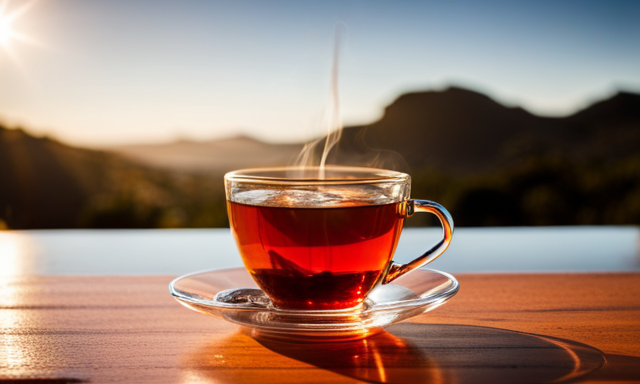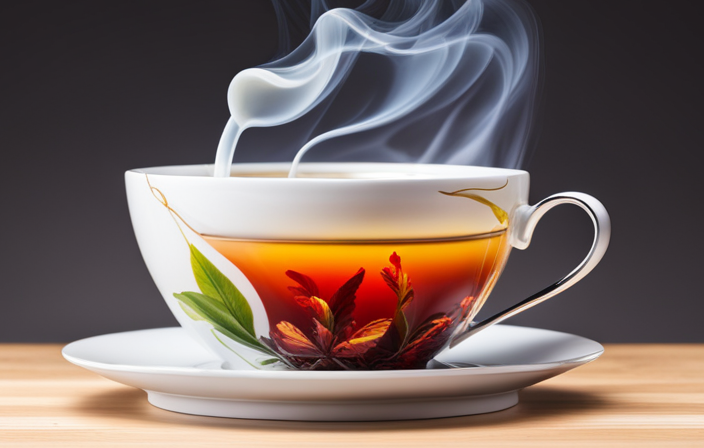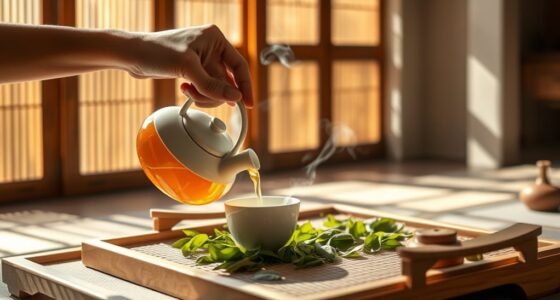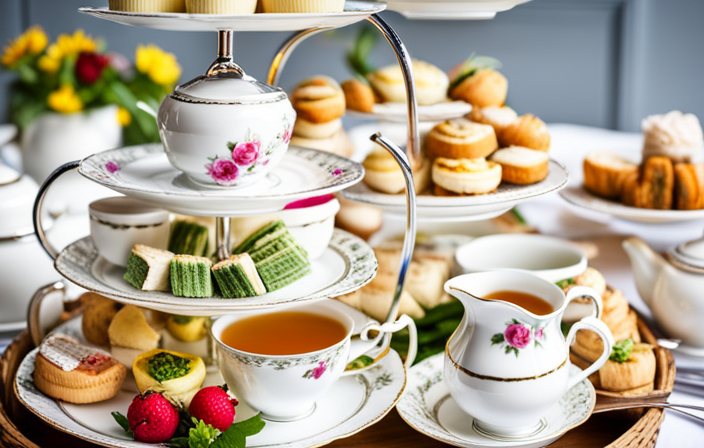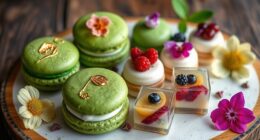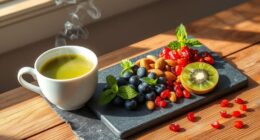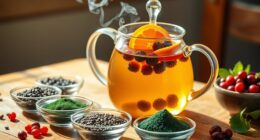I’ve got a secret to share with you – the art of making a perfect tea infusion.
Picture this: a warm cup of fragrant tea, steeped to perfection, ready to soothe your senses.
In just seven simple steps, I’ll guide you through the process of choosing the right leaves, preparing the water, and mastering the art of steeping.
Along the way, I’ll reveal some optional enhancements to elevate your tea experience.
Get ready to impress and delight with your newfound tea-making expertise.
Let’s dive in!
Key Takeaways
- Choose high-quality tea leaves and consider their origin and organic options.
- Use the appropriate water temperature for different types of tea to avoid bitterness.
- Measure the tea leaves accurately and adjust according to taste preferences.
- Select the right type of strainer and serve the infusion at the recommended temperature.
Choosing the Right Tea Leaves
I always make sure to choose the right tea leaves for my brew, so that I can enjoy a flavorful and aromatic cup of tea.
When it comes to tea, there are so many different varieties to choose from, each with its own unique flavors and health benefits. Whether it’s a classic black tea, a soothing herbal tea, or a delicate green tea, the quality of the leaves is crucial in achieving the perfect brew.
I look for tea leaves that are whole and intact, as they tend to retain more of their natural oils and flavors. Additionally, I pay attention to the origin of the tea and opt for organic options whenever possible.
Preparing the Water Temperature
To achieve the perfect cup of tea, it’s important to use the right water temperature, which can be determined by both the type of tea and the number of minutes it needs to steep.
The temperature of the water plays a crucial role in extracting the flavors and aromas from the tea leaves. For delicate teas such as green or white tea, the water should be heated to around 160-175°F (70-80°C). This temperature allows the leaves to steep gently, resulting in a light and refreshing brew.
On the other hand, black and herbal teas require hotter water, around 200-212°F (90-100°C), to fully release their flavors. It’s important to note that boiling water can make tea taste bitter and astringent, so it’s best to let it cool for a few minutes before pouring it over the leaves.
Measuring the Tea Leaves
After carefully measuring the tea leaves, I add them to the teapot and mix them with the hot water. Measuring accuracy is crucial when making a tea infusion. The right amount of tea leaves will ensure a balanced and flavorful cup. When experimenting with proportions, you can adjust the intensity and strength of your tea according to your personal preference.
Here are three key points to consider when measuring tea leaves:
-
Start with the recommended amount: Follow the instructions on the tea packaging as a starting point for measuring accuracy. This will give you a baseline to work with.
-
Adjust to taste: If you prefer a stronger cup, increase the amount of tea leaves slightly. For a milder flavor, decrease the quantity. Remember to take notes during your experiments to replicate your desired results.
-
Find your perfect balance: It may take a few tries to find the ideal proportion of tea leaves that suits your taste. Don’t be afraid to play around with different amounts until you achieve the flavor profile you desire.
By mastering the art of measuring accuracy and experimenting with proportions, you can create a tea infusion that perfectly suits your preferences.
Now, let’s move on to the next step: steeping time and techniques.
Steeping Time and Techniques
Let’s carefully monitor the steeping time and choose the right technique to extract the optimal flavor from our tea leaves.
When it comes to steeping techniques, there are a few key factors to consider.
Firstly, the temperature of the water plays a vital role in the infusion process. Different types of tea require different temperatures, so it’s important to know the ideal range for your chosen tea.
Additionally, the duration of steeping can greatly affect the flavor profile. Too short, and the tea may lack depth; too long, and it can become bitter. It’s crucial to follow the recommended steeping times for each type of tea to achieve the best results.
By mastering these infusion brewing tips, we can elevate our tea experience and serve a truly delightful cup to our guests.
Now, let’s move on to the next step: straining and serving the infusion.
Straining and Serving the Infusion
When straining and serving the infusion, it’s important to choose the right type of strainer to remove any tea leaves or other particles. A fine mesh strainer or a tea ball can be used for loose leaf teas, while a paper filter is suitable for tea bags.
Additionally, make sure to serve the infusion at the appropriate temperature to fully enjoy its flavors and aromas.
Strainer Types for Infusion
I prefer using a fine mesh strainer for my tea infusions because it effectively removes any loose leaves or particles. When it comes to choosing a strainer for your tea, there are a few options to consider. Here are some key factors to keep in mind:
Different strainer materials:
- Stainless steel: This is a popular choice as it’s durable and easy to clean.
- Silicone: These strainers are heat-resistant and flexible, making them great for steeping tea in different-sized containers.
- Bamboo: For those looking for a more eco-friendly option, bamboo strainers are a sustainable choice.
Strainer size options:
- Small handheld strainers: These are perfect for individual cups or mugs.
- Medium-sized strainers: Ideal for brewing larger quantities of tea.
- Large pot strainers: These are designed to fit over teapots or larger vessels, making it easy to strain directly into the serving container.
Temperature for Serving
Usually, I prefer to strain and serve my tea infusion at a slightly lower temperature to avoid any potential bitterness, but you can adjust it according to your taste preferences.
When it comes to serving tea, the temperature plays a crucial role in enhancing the flavors and ensuring a delightful experience.
For delicate herbal infusions, a temperature between 175°F and 185°F is recommended, as it allows the flavors to develop without becoming overpowering.
Black teas, on the other hand, are best served at higher temperatures, around 200°F, to bring out their robustness.
Green teas thrive at lower temperatures, around 160°F to 175°F, to preserve their delicate, grassy notes.
Oolong teas can be enjoyed between 185°F and 195°F, striking a balance between black and green teas.
Adding Sweeteners and Enhancements (Optional
I usually add a teaspoon of honey to enhance the flavor of my tea infusion. Sweeteners and flavor enhancements are optional additions that can take your tea experience to the next level. Here are three options to consider:
-
Natural Sweeteners
- Honey: Known for its rich, floral taste, honey is a popular choice for sweetening tea.
- Maple Syrup: This natural sweetener adds a subtle sweetness and a hint of caramel flavor.
- Stevia: A calorie-free alternative, stevia is a plant-based sweetener with a slightly herbal taste.
-
Spices and Herbs
- Cinnamon: A dash of cinnamon adds warmth and depth to your tea, perfect for cozy winter evenings.
- Ginger: Known for its spicy kick, ginger can provide a zesty twist to your tea infusion.
- Mint: Refreshing and invigorating, mint leaves can bring a cool and soothing element to your cup.
-
Citrus Zest
- Lemon: A squeeze of fresh lemon juice or a few strips of lemon zest can brighten up your tea and add a tangy kick.
- Orange: The zest of an orange can lend a citrusy aroma and a burst of flavor to your tea infusion.
- Grapefruit: For a slightly bitter and tangy note, try adding a twist of grapefruit zest to your tea.
These sweetener options and flavor enhancements can elevate your tea experience, allowing you to customize your infusion to suit your taste preferences. Remember to experiment and find your perfect combination!
Storing and Enjoying Your Tea Infusion
When it comes to storing your tea infusion, it’s important to keep it in an airtight container away from light, moisture, and strong odors to maintain its freshness and flavor.
Different types of tea infusions can offer a variety of flavors, from floral and fruity to earthy and robust, allowing you to explore and enjoy a range of taste experiences.
Lastly, the temperature at which you serve your tea infusion can greatly impact its flavor profile, with some teas tasting best when enjoyed hot, while others are more enjoyable when served chilled or over ice.
Proper Tea Storage
Storing my tea properly is crucial to preserving its flavor and freshness. As a tea enthusiast, I’ve explored various tea storage methods to ensure that my teas maintain their exquisite taste. Here are three key tips for preserving tea freshness:
-
Proper Container: I always store my teas in airtight containers made of glass or ceramic. These materials help prevent exposure to moisture, light, and odor, which can degrade the flavor of the tea.
-
Ideal Temperature: Tea is sensitive to temperature variations, so I store it in a cool, dry place away from direct sunlight and strong odors. Maintaining a consistent temperature helps preserve its delicate flavors.
-
Rotation: To ensure maximum freshness, I rotate my tea collection regularly. This prevents teas from sitting unused for too long, as even properly stored tea can lose some of its flavor over time.
Infusion Flavor Variations
To enhance the flavor of my tea infusion, I enjoy experimenting with different ingredients and spices, such as adding a dash of cinnamon or a squeeze of lemon. It’s amazing how a simple addition can completely transform the taste and aroma of a cup of tea. Not only do these creative infusion combinations add depth and complexity to the flavor, but they also offer a variety of health benefits. For example, adding fresh ginger to my tea infusion not only gives it a spicy kick but also helps with digestion and boosts the immune system. Another favorite combination of mine is chamomile and lavender, which not only creates a soothing and calming blend but also promotes relaxation and better sleep. The possibilities are endless when it comes to creating unique and flavorful tea infusions!
| Infusion Combination | Flavor Profile | Health Benefits |
|---|---|---|
| Cinnamon and Orange | Warm and citrusy | Boosts metabolism, anti-inflammatory |
| Mint and Lemon | Refreshing and tangy | Aids digestion, relieves headaches |
| Turmeric and Black Pepper | Spicy and earthy | Anti-inflammatory, improves digestion |
Serving Temperature Preferences
I personally prefer enjoying my tea infusion at a warm temperature, but some people might enjoy it chilled or at room temperature. The serving temperature of tea can greatly impact its flavor profile, enhancing or diminishing certain characteristics.
Here are three serving temperature options to consider:
-
Warm Temperature:
-
This brings out the full flavor and aroma of the tea.
-
It allows the delicate nuances of the tea to shine.
-
Ideal for teas with complex flavor profiles, like oolong or black tea.
-
Chilled:
-
Creates a refreshing and crisp taste.
-
Perfect for hot summer days.
-
Best suited for lighter teas, such as green or white tea.
-
Room Temperature:
-
A middle ground between warm and chilled.
-
Allows the tea to breathe and develop its flavors.
-
Works well for herbal infusions with bold flavors.
Ultimately, the serving temperature should complement the tea’s flavor profile and cater to individual preferences. Experimenting with different temperatures can lead to delightful discoveries and a truly personalized tea experience.
Frequently Asked Questions
Can I Use Any Type of Tea Leaves for Making a Tea Infusion?
Yes, you can use any type of tea leaves for making a tea infusion. It’s one of the alternative tea brewing methods that allows you to explore a wide range of flavors and aromas.
Using loose tea leaves in your infusion has its benefits. It allows for better extraction of the tea’s natural oils and flavors, resulting in a richer and more flavorful cup of tea. Plus, it gives you the freedom to customize your tea blend according to your preferences.
How Do I Know the Correct Water Temperature for Steeping Different Types of Tea?
Knowing the correct water temperature for steeping different types of tea is crucial in order to achieve the perfect infusion.
Steeping techniques vary depending on the type of tea you’re using. Green teas, for example, require a lower water temperature of around 175°F to 185°F, while black teas typically require boiling water.
How Do I Measure the Right Amount of Tea Leaves for My Tea Infusion?
When it comes to measuring the right amount of tea leaves for a tea infusion, there are a few techniques you can try.
One method is to use a tablespoon to measure out the desired amount of tea leaves.
Another option is to use a scale to weigh the tea leaves for precise measurements.
It’s also worth experimenting with different amounts to find the perfect balance of flavors for your taste.
Are There Any Alternative Steeping Techniques Apart From Traditional Methods?
There are indeed alternative infusion techniques that can be used apart from traditional methods. These techniques allow for more creative tea infusions and can add a unique twist to your tea experience.
By experimenting with different steeping times, temperatures, and even using unconventional ingredients like herbs or fruits, you can create flavorful and aromatic teas that are tailored to your taste preferences.
These alternative methods offer a chance to explore and expand your tea repertoire.
How Long Can I Store My Tea Infusion Before It Goes Bad?
The shelf life of a tea infusion depends on how it’s stored. Proper storage is key to preserving the freshness and flavor of the infusion.
To maximize shelf life, store the infusion in an airtight container in a cool, dark place away from moisture and strong odors.
Generally, a tea infusion can be stored for up to a year without losing its quality. However, it’s recommended to consume the infusion within six months for the best taste.
Conclusion
In conclusion, crafting a tea infusion is a delightful and fulfilling experience, allowing you to savor the soothing flavors and aromas that tea has to offer.
By following these simple steps, you can create a perfectly balanced and invigorating infusion that’s sure to please your senses.
So go ahead, indulge in the art of tea-making and embark on a journey of tranquility and indulgence.
Cheers to a cup of pure bliss!


